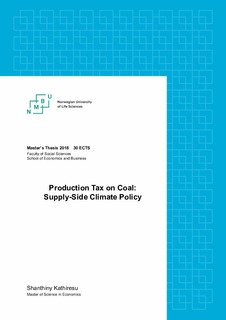| dc.description.abstract | The reduction in coal consumption is seen as one of the key points to support 1.5-2oC target under the Paris COP21 agreement. In the absence of a globally agreed governance mechanism for climate mitigation, demand-side climate policies are vulnerable to more carbon leakages and other adverse effects. Alternatively, supply-side climate policies reflect direct approach to reduce global consumption of coal by restricting the supply. This paper examines the feasibility of a production tax on coal by major coal exporting country and countries as a supply-side climate policy option. I construct a multi-period equilibrium model of the international steam coal market and model a production tax on steam coal in three different scenarios; unilateral tax by Australia (lower and higher tax growth rate) and coalition tax by major exporting countries.
The results show that the unilateral climate policy by Australia reduces of global CO2 emissions. At the same time, unilateral policy under a lower tax rate leads to lower impact in global CO2 emissions than the higher tax growth rate. However, the unilateral tax by Australia has little impact on global CO2 emissions and coal prices as other countries compensate for the reduced supply from Australia. By contrast, tax coalition by major exporters would significantly reduce global CO2 emissions from steam coal. As many countries join the coalition, reduction in extraction would be much higher and would have a greater effect on global consumption with smaller rates of carbon leakages.
I also analyse the sensitivity of the demand and supply elasticities to the tax policies. These results show that if supply elasticity is higher than the demand elasticity, then it leads to higher rises in emission in non-taxing countries (severe leakage, around 78%) under unilateral climate policy. However, if countries jointly introduce tax, then the leakage rate could be reduced and global CO2 emissions are reduced significantly. By contrast, when demand elasticity is relatively higher than supply elasticity, then the tax policy (unilateral or coalition) would yield greater reduction in global CO2 emissions with much lower leakage rate. Generally, demand and supply elasticities are much closer in the steam coal market. Therefore, tax on coal production leads to reduction of global CO2 emissions under both a unilateral or a coalition tax policy. However, the emission reduction under a coalition policy appears much stronger than unilateral. | nb_NO |

